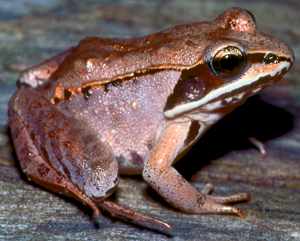By Stephanie Bradshaw, MNA Volunteer

Wood Frog. Photo: Jim Harding/Michigan DNR
As the cold winds and icy showers come over the land, many animals migrate and others find a warm spot to curl up with full stomachs for a long winter nap. For Michigan, temperatures can get so cold that we often joke that one would freeze solid just by stepping outside, and that is exactly what our friend the wood frog does to survive the winter.
How do they freeze themselves?
Wood frogs are able to live farther north than any other type of frog. How do they handle the freezing temperatures? As the temperatures cool, the frogs bury themselves in the mud. As the ground freezes, the water in their body pools into their center, around their vital organs, and they freeze solid. These frogs are as hard as stones or bricks of ice. The frogs exhibit no sign of life: they do not breathe, they do not even have a heartbeat. But, they are not dead. Scientists call this “suspended animation.”
Freezing can cause many severe damages such as dehydration, cell damage, and punctured blood vessels. To avoid damages, the wood frog floods its systems with a sugary, glucose substance that retains the cells’ water and prevents cells from freezing. So while the frog allows freezing to occur around the cells and organs, the glucose protects the cells from the damages of freezing.
How do they thaw themselves?
For reasons still unknown to scientists, wood frogs are able to thaw themselves in the spring. Even more amazing, they thaw from the inside out, their vital organs becoming active in perfect timing so that the frog can regain full life. This process of coming back to life takes one or two days.
After the frogs have warmed up, they are ready to begin their mating season. Since the ground thaws before the lakes and ponds, wood frogs are the first frogs to awaken in the spring. Mating earlier than other species gives them an advantage for their youth to grow and mature before summer begins.
Possible Applications for Humans
The blood sugar that the frogs use to secure their organs and cells is the same blood sugar as all other vertebrate animals, including humans. With more research into the secrets of the wood frog, scientists may discover ways of storing and reviving organs without damage to tissues, managing blood sugar for diabetics, and treating people after strokes and heart attacks where their blood ceased to flow.
